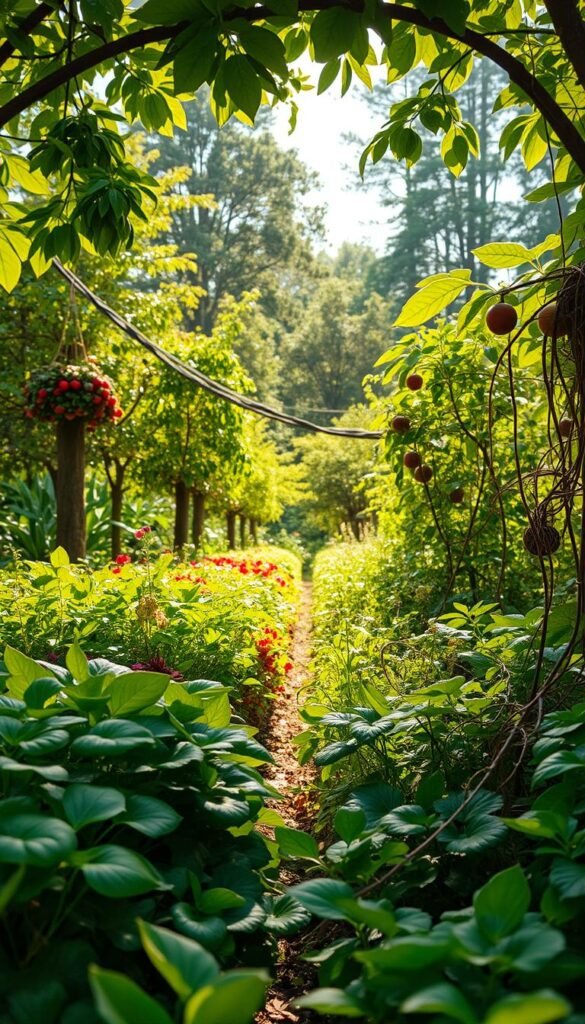Imagine transforming your outdoor space into a thriving ecosystem that grows fresh, organic food year after year. A permaculture food forest does exactly that by mirroring natural forest patterns. Instead of traditional rows of crops, this approach layers trees, shrubs, and ground covers to create a self-sustaining edible landscape.
Think of it as a living pantry. Tall fruit trees form the canopy, while berry bushes and herbs fill the understory. Vining plants climb trellises, and root vegetables nestle below. Each layer supports the others, reducing weeds and pests naturally. Best of all, once established, these systems require minimal upkeep compared to annual gardens.
Perennial plants are the backbone of this design. They return every season, saving you time and effort. You’ll also attract pollinators and improve soil health without chemicals. Plus, the diversity of species ensures a steady harvest across different seasons.
Ready to learn how to plan your own low-maintenance oasis? Later sections will break down practical steps, from choosing climate-friendly species to maximizing space. Let’s turn your yard into a resilient source of nourishment.
Introduction to Permaculture Food Forests
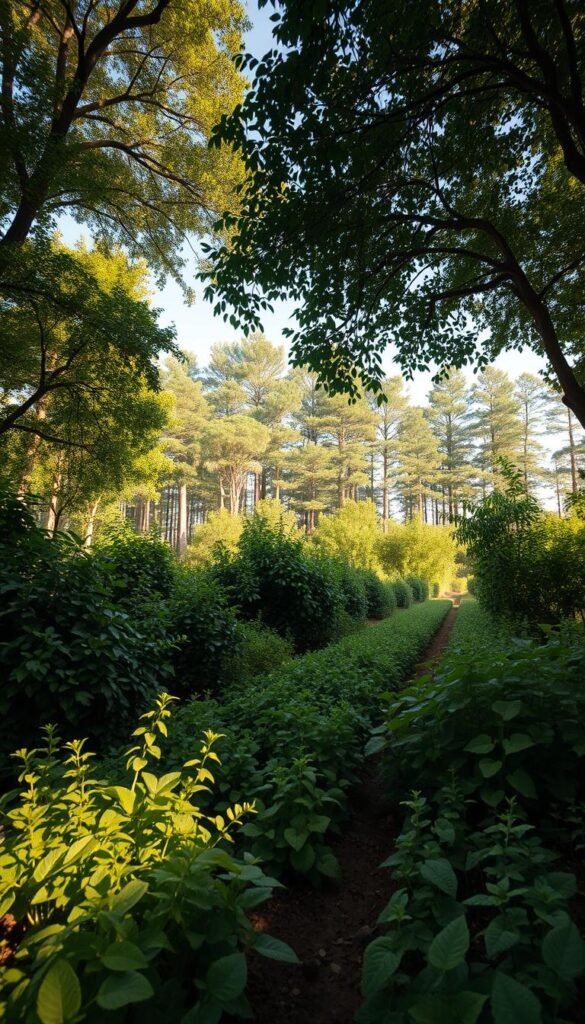
Discover how layered plant communities can turn your yard into a sustainable pantry. Unlike conventional gardens, these ecosystems thrive by working with nature rather than against it. They borrow strategies from wild woodland edges, where diverse species grow together in mutually beneficial relationships.
What Is a Food Forest?
A food forest mimics natural forests but focuses on edible species. Tall trees like apples or pecans form the upper layer, while shrubs such as blueberries occupy the middle. Herbs, mushrooms, and ground covers complete the system. This vertical design maximizes space and creates microclimates that protect plants.
Benefits of a Permaculture Approach
Traditional gardens demand constant weeding and watering. Permaculture systems, however, use companion planting to reduce maintenance. For example, nitrogen-fixing plants enrich soil naturally, while flowers attract pollinators. Over time, these spaces become self-sustaining.
Perennial crops like asparagus or rhubarb return yearly, saving replanting effort. According to permaculture expert Matthew Britt, this method also supports local wildlife. Historical examples, like Mesoamerican “milpa” systems, show how layered gardens fed communities for centuries.
Planning Your Backyard Food Forest
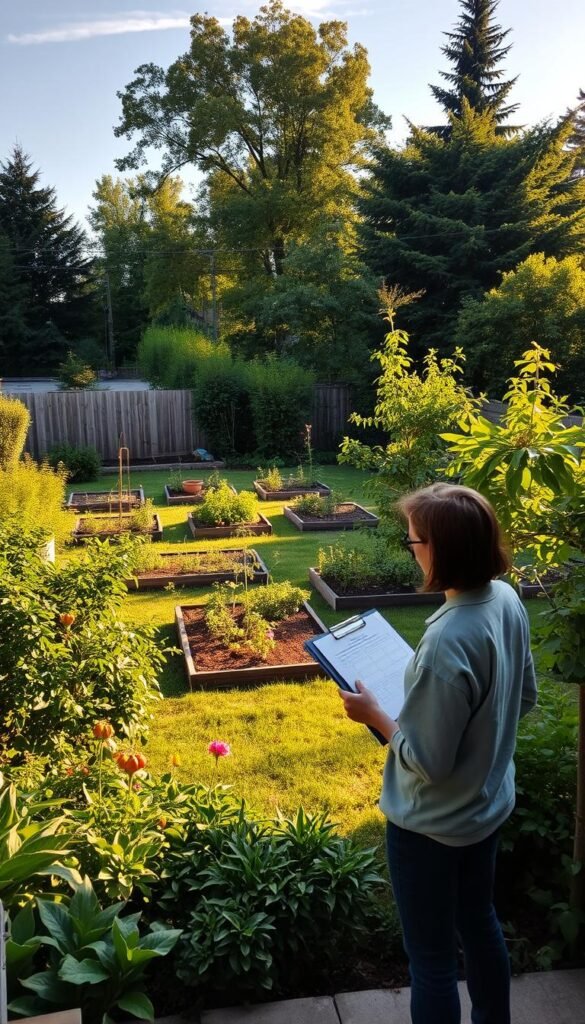
Start by sketching your available area on graph paper or using free digital mapping tools. Note sunlight patterns, slopes, and existing structures. Even small spaces can host abundant yields when planned thoughtfully.
Evaluate Your Site’s Potential
Identify microclimates—shady corners, windy zones, or damp areas. Test soil pH and texture with a $10 kit from garden stores. For example, blueberries thrive in acidic soil, while figs prefer well-drained spots.
Choose Climate-Smart Species
Visit nurseries to discover native edibles like pawpaws or serviceberries. These plants resist pests and need less water. Pair them with proven performers like dwarf apple trees or thornless blackberries.
| Plant Type | Native Species | Non-Native Options |
|---|---|---|
| Canopy Trees | Persimmon | Asian Pear |
| Shrubs | Elderberry | Goji Berry |
| Ground Covers | Wild Strawberry | Alpine Mint |
Layer plants vertically to mimic natural growth. Tall trees provide shade for shade-tolerant herbs below. Allow pathways for maintenance access—you’ll thank yourself during harvest season!
Soil, Water, and Climate Considerations for Food Forests
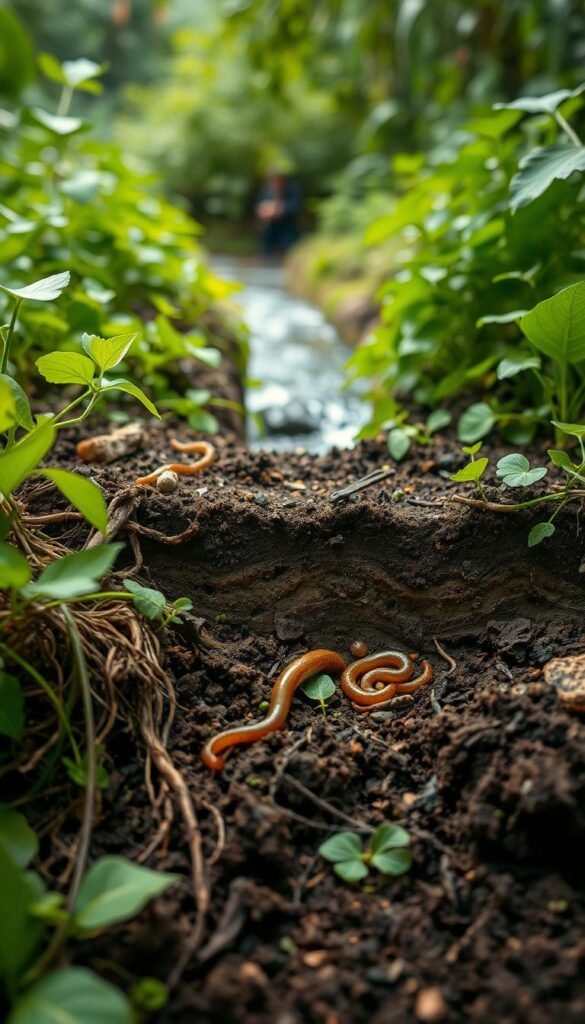
Healthy soil forms the foundation of any thriving ecosystem. To build resilience, focus on nurturing earth structure while managing moisture and temperature shifts. Let’s explore how to create conditions where plants flourish with minimal intervention.
Improving Soil Health Naturally
Boost fertility without chemicals by working organic matter into your site. Fallen leaves, grass clippings, and kitchen scraps become nutrient-rich compost over time. Spread this “black gold” around trees and crops to feed beneficial microbes.
In dry climates, use swales—shallow ditches—to capture rainwater. Pair them with drought-tolerant species like figs or rosemary. For wet areas, plant water-loving options such as elderberry or mint near drainage paths.
| Organic Amendment | Benefits | Application |
|---|---|---|
| Compost | Adds nutrients | Top-dress beds annually |
| Leaf Mold | Improves texture | Mix into planting holes |
| Wood Chips | Retains moisture | Layer around shrubs |
Native practices offer inspiration. Indigenous communities often used three-sister planting—corn, beans, and squash—to protect soil. Similarly, clover makes a living mulch that suppresses weeds while fixing nitrogen.
Design Layers: From Canopy Trees to Ground Covers
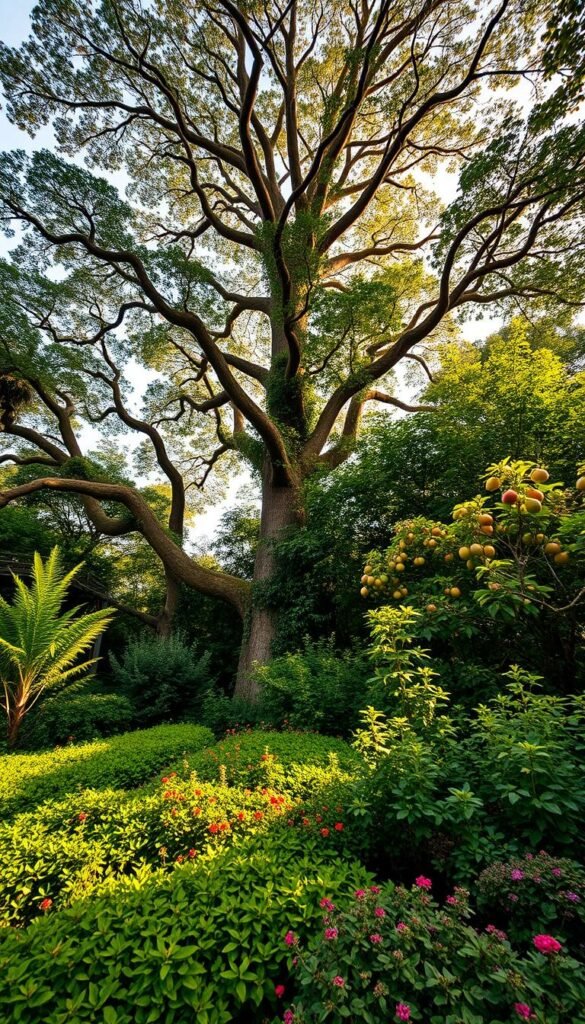
A well-structured edible landscape operates like nature’s skyscraper, stacking plants vertically to boost productivity. By working across seven distinct layers, you’ll harness sunlight efficiently while creating habitats for beneficial insects. This approach transforms limited space into a lush, edible paradise.
Understanding Vertical Planting Techniques
Start with tall canopy trees like apples or pecans that provide shade and wind protection. Below them, dwarf fruit trees or hazelnut shrubs form the understory layer. Berry bushes and herbs thrive in partial sunlight, while vining crops like grapes climb trellises.
Ground covers such as strawberries suppress weeds and retain moisture. Deeper-rooted vegetables like carrots grow beneath them. Each layer supports the others, creating a dense ecosystem that outcompetes weeds naturally.
Creating Effective Plant Guilds
Pair plants that benefit each other. For example, surround an apple tree with comfrey (for nutrient-rich mulch) and garlic (to deter pests). Add flowering plants like yarrow to attract pollinators. These groupings mimic natural communities, reducing the need for fertilizers.
When selecting species, prioritize those with multiple roles. Elderberry shrubs offer edible flowers and berries while repelling deer. Nitrogen-fixing plants like clover enrich soil for nearby crops. Over time, these partnerships create a self-regulating system.
By thoughtfully arranging layers and guilds, you’ll build a resilient space that produces abundant harvests with minimal effort. The result? A thriving ecosystem that feeds both people and wildlife.
Designing a Permaculture Food Forest in Your Backyard
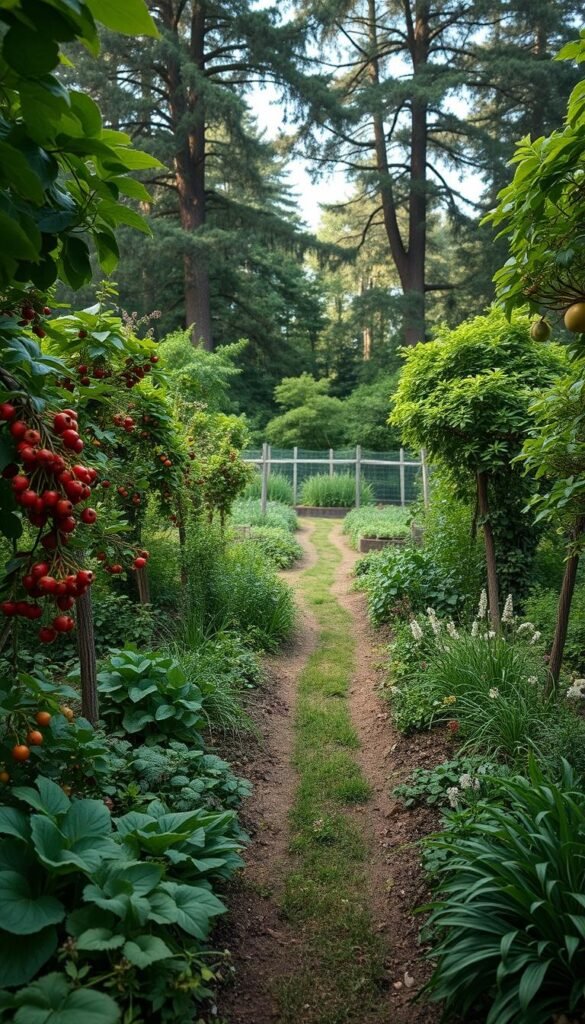
Crafting an edible ecosystem starts with observing nature’s patterns. Mimic natural forests by stacking plants vertically—tall canopy trees shelter shrubs, which in turn protect herbs below. This layered approach maximizes space while creating habitats for pollinators and birds.
Balance beauty and practicality by designing curved pathways between plant guilds. Add flowering species like calendula for color contrast. Edible vines on arbors create living archways that boost yields without sacrificing style.
Follow these steps to plan your layout:
- Map sunny vs. shaded zones using free apps like Sun Seeker
- Place nitrogen-fixing species near heavy feeders like fruit trees
- Allow 15-20 feet between large canopy trees for root development
| Feature | Traditional Garden | Food Forest |
|---|---|---|
| Layout | Straight rows | Curved, natural patterns |
| Maintenance | Weekly weeding | Seasonal pruning |
| Yield Timeline | Annual harvests | Decades of production |
Urban gardener Maria Rodriguez transformed her 1/4-acre lot into a lush oasis. Dwarf citrus near her patio underplanted with thyme and strawberries now provides daily ingredients. “It’s like shopping in my yard,” she says.
Your edible landscape will evolve over years as plants mature and self-seed. Start small—even a 10×10 area can yield abundance. Document changes yearly to refine your approach.
Maintenance Strategies for a Low-Maintenance Garden
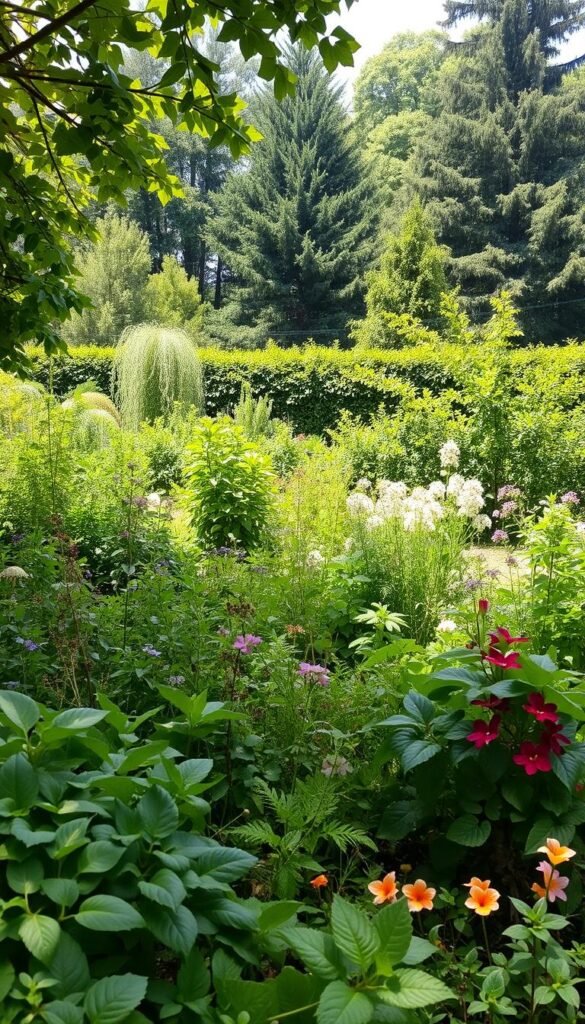
Keeping your edible landscape thriving doesn’t require endless hours—just smart strategies. By syncing tasks with nature’s rhythms and letting plants work together, you’ll spend less time maintaining and more time harvesting. Here’s how to nurture your green space efficiently.
Seasonal Tasks Made Simple
Prune fruit trees in late winter when they’re dormant. This prevents disease and boosts summer yields. Come spring, refresh mulch around shrubs to lock in moisture. Fall is ideal for planting new perennials—cooler temps help roots establish.
| Season | Key Tasks | Frequency |
|---|---|---|
| Winter | Prune trees, compost leaves | Once |
| Spring | Mulch beds, plant annuals | Monthly |
| Summer | Harvest, weed pathways | Biweekly |
| Fall | Plant perennials, collect seeds | Once |
Nature’s Pest Control Team
Attract ladybugs by planting dill or fennel—they devour aphids. Spread crushed eggshells around vegetable patches to deter slugs. For persistent weeds, smother them with cardboard topped with wood chips.
| Natural Method | Purpose | Best For |
|---|---|---|
| Companion planting | Repels pests | Tomatoes + basil |
| Chicken tractors | Weed control | Large areas |
| Neem oil spray | Fungal issues | Fruit trees |
Urban gardener Lisa Nguyen shares: “Since adding marigolds around my berry bushes, Japanese beetles vanished.” These small steps create big impacts, letting your food forest flourish with minimal fuss.
Utilizing Community Resources and Expert Advice
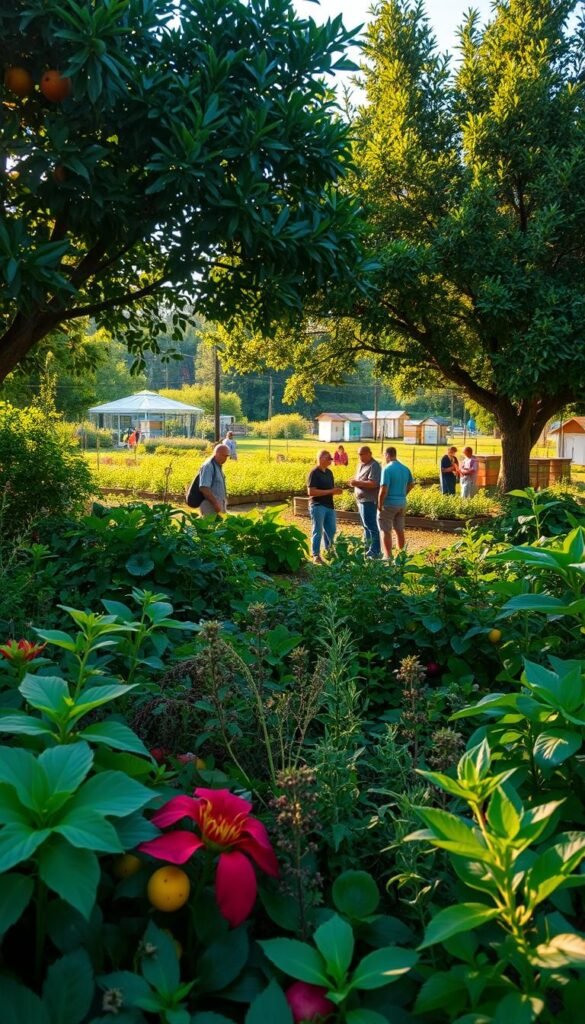
Building a thriving edible ecosystem becomes easier when you tap into collective wisdom. Local experts and fellow gardeners often hold insights you won’t find online. Their knowledge helps avoid costly mistakes while accelerating your project’s success.
Connecting with Local Nurseries and Permaculture Programs
Start by visiting nurseries specializing in native species. Staff there know which trees and shrubs thrive in your area’s soil and climate. Many offer free planting guides or host seasonal workshops on forest garden basics.
Join regional permaculture groups through platforms like Meetup or Facebook. The community often shares surplus plants, organizes seed swaps, or arranges expert consultations. For example, Portland’s Food Forest Collective helped 40+ households establish edible landscapes last year.
Explore these resources to boost your skills:
- Free USDA plant hardiness zone map for species selection
- Library-hosted permaculture book clubs
- University extension programs offering soil testing
Urban farmer Jamal Carter credits his lush food forest to a local mentor. “She taught me how to graft fruit trees properly,” he says. “Now I share cuttings with neighbors.” By building relationships, you’ll gain practical tips while contributing to greener neighborhoods.
Incorporating Multi-Functional Design Elements and Innovations
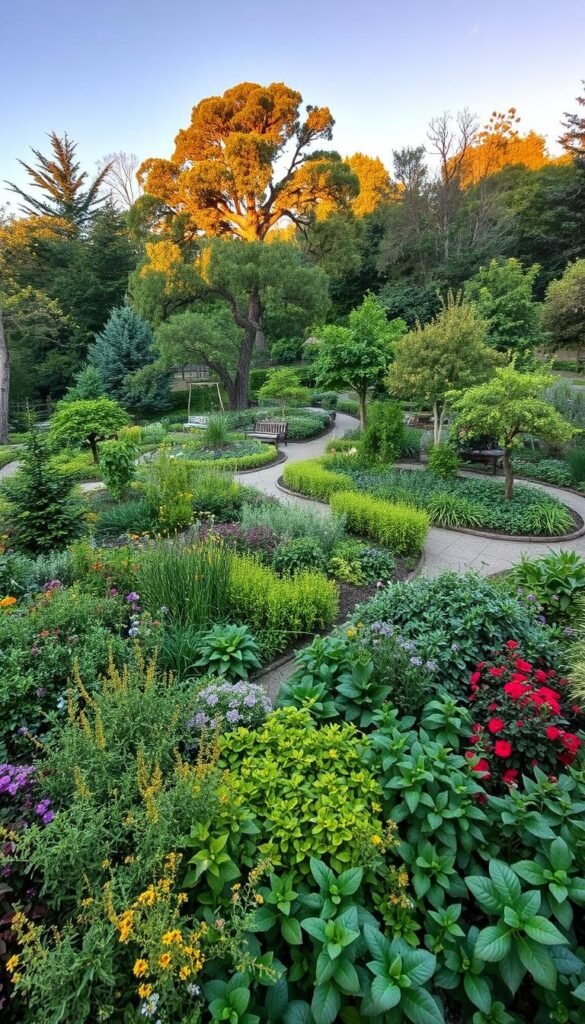
Blend beauty and purpose by crafting areas that nourish both people and local wildlife. Strategic design choices turn your edible landscape into a vibrant habitat while boosting crop yields. Let’s explore how to create spaces where plants and creatures thrive together.
Wildlife-Friendly Growing Zones
Leave some berry bushes unharvested for birds, and plant milkweed to support monarch butterflies. A small pond attracts frogs that eat slugs—nature’s pest control team. Brush piles offer shelter for beneficial insects like ground beetles.
Case in point: Seattle’s Beacon Hill Food Forest increased pollinator visits by 60% after adding native flowering shrubs between fruit trees. Their yields rose while reducing manual pollination efforts.
Build Your Own Garden Helpers
Repurpose materials for practical structures. Old pallets become vertical herb walls, while cattle panels arched over paths support grapevines. Cold frames made from recycled windows extend your growing season affordably.
| DIY Project | Materials Needed | Benefits |
|---|---|---|
| Compost Bin | Wooden pallets + wire | Enriches soil naturally |
| Insect Hotel | Bamboo + clay pots | Shelters pollinators |
| Trellis System | Copper pipes + twine | Maximizes vertical space |
Try these space-smart ideas:
- Train kiwi vines over arbors to create shaded seating areas
- Use raised beds with built-in nesting boxes for mason bees
- Install rain chains that direct water to thirsty crops
Looking for inspiration? The Giving Grove initiative showcases how communities blend food production with ecological benefits. Pair these concepts with space-efficient growing techniques for maximum impact.
Your edible oasis can become a living classroom. Observe which designs attract the most bees or which structures withstand storms best. Every creative tweak makes your system more resilient and productive.
Harvesting Success: Embracing Your Food Forest Journey
Your journey toward a thriving edible landscape begins with a single step—and grows richer each season. By layering plants strategically and partnering with nature, you’ll enjoy fresh food while nurturing local ecosystems. Communities like Seattle’s Beacon Hill Food Forest show how these spaces flourish, yielding 5,000+ pounds of produce annually with less maintenance than traditional plots.
Success stories prove patience pays off. Urban gardener Elena Martinez harvested her first pawpaws three years after planting. Now, her backyard provides figs, herbs, and berries year-round. “It’s not just about the crops,” she says. “It’s watching birds nest in the canopy and soil come alive.”
Every season offers rewards. Spring brings blossoms for pollinators, summer delivers juicy fruits, and fall invites seed-saving for future growth. Preserve your bounty by freezing berries, drying herbs, or fermenting kimchi from perennial greens.
Start small, celebrate progress, and let your forest-inspired garden evolve. Share cuttings with neighbors, journal changes, and savor meals grown steps from your door. With time, your living pantry will mirror nature’s resilience—feeding both body and soul.

